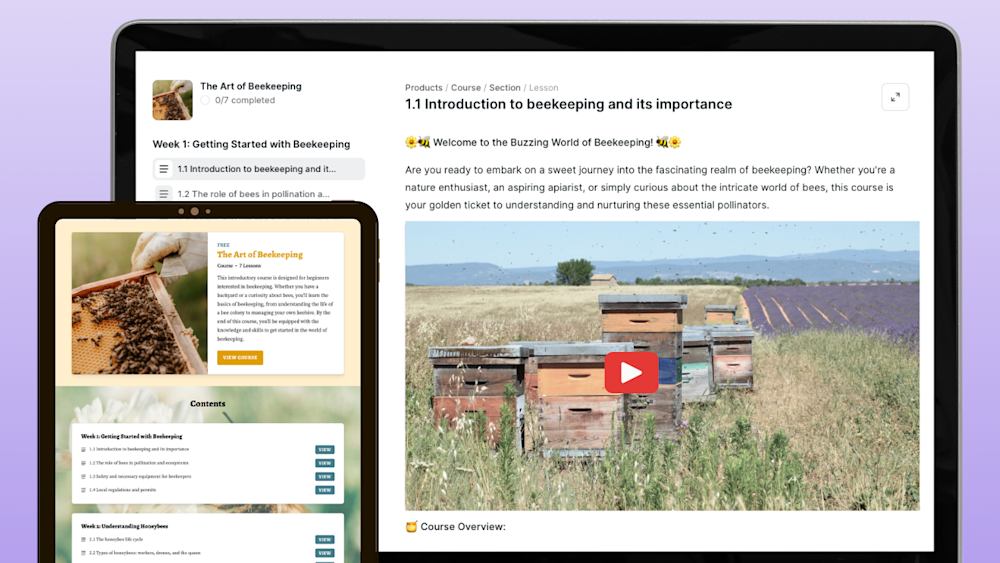You know creating an online course or membership site could really help your followers and revenue.
But you can only pick one (right now, anyway), and it feels like no matter which you choose, you’ll make the wrong choice.
It’s an understandable dilemma. Online courses and membership sites have a lot of commonalities, but there are some distinct differences, too.
Workflow, time commitment, and price tag are just three of the most top-level differences.
The more you drill down into it, the worse it gets.
That’s why we’ve put together this comprehensive breakdown of the pros and cons, time and effort, idea validation, and revenue potential for each kind of digital product.
Let’s get started with a top-level view of the basic pros and cons first.
Online courses vs. Memberships: Pros and Cons
When it comes to choosing between creating an online course and creating a membership site, the decision isn’t which is better, but rather which advantages you prefer and what disadvantages you’re willing to handle.
Online courses: Pros
-
Well-suited for topics where students will learn one tangible skill or achieve one measurable result by the course’s end
-
Works for project-based tutorial content, such as how to play the guitar
-
Best for evergreen content that changes slowly or not at all, such as yoga poses for beginners
-
Easy to validate your product ideas using YouTube videos, webinars, and other video-based mediums
-
Minimal post-launch maintenance and updates compared to membership sites
-
High potential sales prices
-
Popular medium for continuing education and development
Online courses: Cons
-
Can be difficult to update without a significant overhaul
-
Revenue growth is limited to new sales
-
Sales typically come in cycles and revenue can be difficult to predict
-
Risk of piracy and theft since viewers can record or share your videos with friends unless you only make the course available via streaming with a platform like Podia
-
Challenging to sustain engagement and participation since students are passively watching the course, not interacting with the teacher or other students
Memberships, on the other hand . . .
Membership sites: Pros
-
Fit well with topics that teach multiple skills, or whose skills and achievements would take several months to realize
-
Great for creators who may want to expand upon or pivot their expertise and offerings in the future
-
Easier to project revenue than with it is with online courses
-
Easier to encourage and measure engagement since you can interact with customers in discussion forums, through mastermind groups, or private coaching
-
Less upfront effort and costs to produce
-
Exclusivity is baked into the membership model since only those who pay can access your membership site’s content
-
Easier to pivot and change according to consumer preferences since your content is created weekly, bi-weekly, and et cetera
-
Generally lower-priced than courses, which can attract more customers
Membership sites: Cons
-
Require ongoing effort and time to produce new content for members, keep them engaged, attract new customers, and so on
-
Lower price point means that it can take longer to become profitable or that you may attract customers who aren’t a good fit for your brand
-
A high potential churn rate, with the average churn rate being 6.12% for all businesses and 7.69% for B2C businesses
Winner:
-
Online courses if you’re teaching a contained topic
-
Online courses if you’d rather sell 10 $100 online courses to make $1,000 than 100 $10 membership plans
-
Memberships if you prefer recurring and semi-predictable revenue that’s spread across multiple customers, and therefore less risky if customers churn
-
Memberships if your product idea teaches multiple tangible skills or helps your students achieve long-term measurable results
Online courses vs. Membership sites: Idea validation
As we mentioned earlier, online courses are better for topics that can be wrapped up into a few videos and digital downloads, whereas memberships are better for broader topics.
However, those aren’t the only areas where online courses and memberships differ -- let’s take a look at which subjects are best-served by online courses and membership sites.
Online courses: Idea validation
Online courses are better for creators who are confident in their course topic and want everything -- the video content, accompanying digital downloads, and more -- bundled into one product.
Online courses are also better for topics that are evergreen or slow-changing as creators won’t need to revamp their course constantly.
Succulents and Sunshine’s “Successfully Growing Succulents” course is an excellent model of a topic that’s best suited for an online course.
Although the course covers multiple subtopics, it teaches one primary skill: how to “grow Pinterest-perfect succulents.”
While Succulents and Sunshine could have turned their course into a membership, it would have been difficult to do so from a content creation perspective.
After all, there are only so many ways to grow healthy succulents, and succulents’ biology and requirements won’t change drastically over the next few years.
OK, now let’s take a look at how to tell what topic would be better executed in a membership format.
Membership sites: Idea validation
Besides being a good fit for broad, multi-faceted topics, memberships work well for creators who are seeking out product validation for their content.
Unlike an online course, where you should have most of your curriculum planned -- or at least outlined -- in advance, memberships allow much more flexibility in terms of what you teach each week.
Therefore, memberships suit creators who want to slowly validate their membership ideas week by week, instead of creating their content all at once.
Think you may want to pivot on what you teach in the future? Then memberships’ ever-changing content gives you the flexibility to alter what topics your product can cover.
Memberships are also great for topics like technology or lifestyle trends, where there are always new updates, developments, and skills to learn.
For example, let’s say you run a Facebook group about homesteading. You’ve sold a few digital downloads about homesteading, but what you really want to do is create an online course.
However, your existing audience is small, and you haven’t gotten enough validation from them that they would be willing to pay for higher-priced products from you.
Your online course idea, while comprehensive, would have hundreds of modules and take months to produce.
Instead of creating your mega-course with little validation, you could instead create a membership site.
You could release a few video modules each week, along with complementary assignments, digital downloads, and coaching.
Sheri Graham’s “Intentional Homemaking” membership, for example, offers members encouragement, community, and accountability -- something that would be hard to do in a one-way online course.
So where does this leave memberships and online courses for different content niches?
Winner:
-
Online courses if you have a tested idea and want to bundle everything into one course
-
Online courses for evergreen or slow-changing topics
-
Memberships if you’re trying out new content or want to expand upon what you teach in the future
-
Memberships if you want to teach the cutting-edge skills and topics in your field
Online courses vs. Membership sites: Time and effort
Online courses and memberships require similar levels of time and effort to produce, although the effort is often spread across significantly different time frames.
Let’s take a look at online courses first.
Online courses: Time and effort
You can think of the time and effort for creating online courses versus memberships as the difference between raising a baby versus a pet: One needs you heavily in the beginning, but gradually becomes self-sustaining.
The other will need you for its entire life.
For an online course, you’ll need to allocate most of your time to the production stage when you’re coming up with online course ideas, designing the course curriculum and assignments, and recording and editing your videos.
After that, most of your time and effort will be spent on marketing, with occasional updates to your course content.
Memberships, conversely, require constant attention and rearing throughout their lifetime.
Fortunately, their neediness (so to speak) is offset by their flexibility.
Membership sites: Time and effort
Membership sites require consistent time and effort from their creators. It's hard to land too many customers for one-off purchases like an online course, but it can be easier than you think to end up with too many clients to handle with a membership program.
Most membership sites can only profit if you continually release content and make members feel like they’re part of a thriving community, after all.
However, whereas online courses have a steep learning curve, memberships can spread their creative efforts and development across multiple weeks.
This flexibility, as we said earlier, comes at the expense of a much longer time commitment and continued (noticeable) improvements.
So, as with many things today, it’s not black-and-white whether online courses or memberships require less time and effort.
Winner:
-
Online courses if you’d rather frontload the work
-
Online courses if you’re short on time in your day-to-day
-
Membership sites if you’d rather spread the workload out over the long haul
-
Membership sites if you can devote time weekly to creating new content
Online courses vs. Membership sites: Production costs
Whereas online courses and memberships can vary significantly in terms of the level of work they each require, their costs are overall quite similar.
For example, both will require:
-
Web hosting if you run your course or membership site on a platform like WordPress.
-
Email marketing functionality and an email service provider so you can grow your email list and spread the word about your course or membership.
-
A video camera, smartphone, or webcam and microphone to record video content for your online courses and memberships.
-
Video editing software, such as Wondershare FilmoraPro, so you can polish up your course and membership videos before release.
-
A place to host your video content so that you won’t slow your site’s or videos performances.
-
An e-commerce platform where you can host and sell your digital products.
As you can tell, selling either an online course or membership can get costly if you aren’t careful about where your money is going.
Selling a course on WordPress costs a minimum of $708.28 in your first year, and $713.76 in your second, with similar figures for selling an online course.
(Psst, if you’re curious, here’s the full breakdown of how much it costs to produce an online course.)
That’s assuming you pick the cheapest tools available, and excludes all of the other plugins you’d need to run your site more generally, by the way.
To take some of the financial burdens off your shoulders, check out Podia.
Creators can sell an unlimited number of online courses, memberships, webinars, and digital downloads on all plans. No additional plugins, tools, or headaches to manage. Get started with Podia for free today.
Otherwise, this is how the production costs breakdown:
Winner:
-
Online courses if you would rather pay most of your production costs all at once
-
Memberships if you’d rather spread out your production costs
Now, let’s talk profits.
Online courses vs. Memberships: Revenue
Both online courses and memberships have a high potential for revenue.
It’s the style that varies more than anything else. Do you like semi-predictable recurring revenue, or are you down for boom periods of sales and drier periods?
If it’s the latter, you might prefer memberships. For the former, online courses may be a better fit. Why? Read on.
Online courses: Revenue
Online courses tend to be much higher priced than online memberships, with 39.06% of courses priced between $5.00 and $50.00, and an average online course price of $182.58.
However, course prices can go much higher -- and lower -- than that.
Class:PR’s “FAMOUS: The Complete Roadmap for PR and Media Coverage” course is priced at $645, for example.
On the other hand, Yann Le Nen’s “Clients Booster” course sells for 197 euros, whereas Elizabeth Stapleton’s “Succeeding with Side Hustles” course is $27.
Even though there are courses available at all price points, there are hundreds of creators profiting handsomely from online course sales.
The founder of Making Sense of Cents earned $434,698 within one year of launching her Making Sense of Affiliate Marketing course, for example.
She’s not the only creator to see success with an online course -- Pinterest strategist Rachel Ngom earned $49,000 in just five days from her online course launch.
However, despite the success many people see with online courses, their higher price tag can deter those who’ve never purchased from you before or who can’t afford to pay your course’s full price.
One way around this problem is by offering coupons or payment plans for your online course, as La Nouvelle École de Créativité did for their “Je Trace Ma Ligne de Vie” course.
One con to income from online courses, however, is that it tends to come it bursts.
For example, it’s not uncommon to see a quarter where you’re making money hand over fist, and then a quarter where you’re barely breaking even.
Memberships, on the other hand, fare differently.
Membership sites: Revenue
Memberships sites tend to be priced lower than online courses.
Nevertheless, memberships can earn more than an online course since members pay ongoing monthly fees to access the membership site.
Just consider creator Abby Pollock, who made $8,000 with her first membership launch and $40,000 with her second launch, and had 80 people join her membership's waiting list each day. .
But to achieve success like Abby’s, you don’t have to price your membership drastically low or sky-high -- like online courses, you’ll find memberships at all price points.
The School of Laughs’ Club 52 membership, for example, is available to anyone who supports his podcast with a $7+ per month donation on Patreon.
Conversely, the Divine Mother Portal’s “Living a New Destiny 2019” membership is priced at $150 per month or $1,650 per year.
But with generally lower prices, what’s the point of recurring revenue if you’re only earning a few dollars per customer per month?
The beauty of memberships is that they distribute your revenue across multiple customers so that if a customer were to cancel her membership, it doesn’t break the bank.
Because memberships are ongoing, it’s also easier for creators to implement referral and affiliate marketing with their members than with customers who purchase a one-time class.
Not only can this take offset some of the marketing and promotional burden, but it can also reward happy customers and help you reach more people.
Next, check out how and where online courses and memberships win -- or don’t -- with profits.
Winner:
-
Online courses if you think you could earn more by selling fewer but higher-priced courses
-
Online courses if you’re comfortable with having sales booms and slow periods
-
Membership sites if prefer having regular recurring revenue
-
Membership sites if you’re selling something that’s lower-priced than a typical course in your field
Choosing the format that's right for you
If you’re debating between creating an online course or membership plan, the good news is both digital products are profitable.
However, each product brings a different set of pros and cons to the table, including:
-
Online courses are better for topics that teach one concrete skill or something which could be taught within a month.
-
Membership sites are better for topics which teach students multiple skills or which would take many months to cover.
-
Online courses suit creators teaching evergreen topics like “how to grow a medicinal herb garden” or “how to run a 5k”.
-
Membership plans fit best with topics that change frequently or which require multiple skills, such as building your own tiny home.
-
Online courses generally require a lot of upfront time effort, but little maintenance afterward.
-
Memberships require regular ongoing maintenance as you come up with content and engage with your members.
-
Online courses are profitable one-time sales, so it’s possible that you’ll see both high-earning and slow periods of sales for your online course.
-
Memberships are also a profitable digital product to sell and provide monthly semi-regular income for their creators.
In short, both online courses and memberships are a great way to add income to your business, and there’s no definitive right-or-wrong answer that applies universally.
It just comes down to what you need and can handle. Best of luck!



